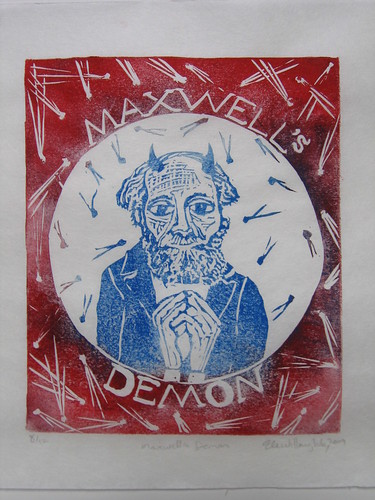
This is a lino block print 8 inches by 9 inches (20.3 cm by 22.9 cm) on Japanese kozo (or mulberry) paper. It is one of a first edition of 12. Colour is somewhat variable.
It is the first in a series about the imaginary friends of scientists. We could get flashy and call them gendankenexperiments*, but, particularly since they are demons, I think Imaginary Friend is a more apt title.
Legendary** Scottish physicist James Clerk Maxwell (1831-1879) dreamt up his demon to deal with the very odd 2nd Law of Thermodynamics (which is not a law like others, and can not be derived from first principles). It states that two bodies of different temperature brought together in a closed system will reach thermal equilibrium; or, you cannot use a cold thing to heat a hot thing; or, entropy or disorder can remain constant or grow; or disorder of a closed system cannot decrease. Hence with time, there will be peanut butter in the jam and jam in the peanut butter; we never find the jam-contaminated peanut butter spontaneously de-mixing.***
"... if we conceive of a being whose faculties are so sharpened that he can follow every molecule in its course, such a being, whose attributes are as essentially finite as our own, would be able to do what is impossible to us. For we have seen that molecules in a vessel full of air at uniform temperature are moving with velocities by no means uniform, though the mean velocity of any great number of them, arbitrarily selected, is almost exactly uniform. Now let us suppose that such a vessel is divided into two portions, A and B, by a division in which there is a small hole, and that a being, who can see the individual molecules, opens and closes this hole, so as to allow only the swifter molecules to pass from A to B, and only the slower molecules to pass from B to A. He will thus, without expenditure of work, raise the temperature of B and lower that of A, in contradiction to the second law of thermodynamics."
Thus entered into history one of the most colourful and storied of the demons of physics. Though he has served to show that no matter how clever, the 2nd law always survives the Demon, somehow, Maxwell's Demon also survives to test the 2nd Law again in new and exotic places, like in information theory and at the event horizon of blackholes.
Notice the big, sharp eyes and the long, nimble fingers; otherwise, Maxwell's Demon bares an uncanny resemblance to Maxwell himself.
* thought experiment - all my German is either from science (gedankenexperiment, eigenparameter, bremsstrahlung and the like) or music.
**if he isn't legendary in your mind, he should be! Einstein himself described Maxwell's work as the "most profound and the most fruitful that physics has experienced since the time of Newton." Not only did he show that electricity and magnetism are two sides of a single coin, he explained the propagation of light (Maxwell's equations), he developed a statistical distribution for the kinetic behaviour of gases (Maxwell's distribution, or Maxwell-Boltzmann Distribution, the beloved bell-curve of the undergraduates), he contributed to electrochemistry, optics and in his spare time dreamt up the delightful anti-entropy Demon.
I once had a goldfish named Maxwell.
***Ultimately, as the Universe (the biggest closed system we know) itself tends towards disorder, it may (depending on which cosmological model best describes reality) acheive its maximum entropy Heat Death, so Maxwell's Demon never struck me as sinister. However, without entropy we loose the psychological arrow of time (i.e. aging), which would complicate life to no end (if you will forgive the esoteric pun).









No comments:
Post a Comment